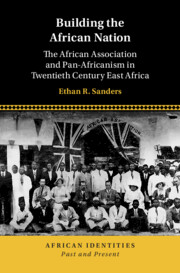Refine search
Actions for selected content:
84 results
Improving Constitutional Adjudication in Francophone Africa through Human Rights Treaties and Case Law: the Benin Constitutional Court
-
- Journal:
- Journal of African Law , First View
- Published online by Cambridge University Press:
- 09 September 2025, pp. 1-15
-
- Article
-
- You have access
- Open access
- HTML
- Export citation
Pan-African Print in Interwar Britain: Ras T. Makonnen and International African Opinion
-
- Journal:
- Transactions of the Royal Historical Society , First View
- Published online by Cambridge University Press:
- 27 August 2025, pp. 1-24
-
- Article
-
- You have access
- Open access
- HTML
- Export citation
1 - Ethiopianism, Redemptive Pan-Africanism, and the African Nation in the Thought of James Aggrey
-
- Book:
- Building the African Nation
- Published online:
- 25 July 2025
- Print publication:
- 14 August 2025, pp 39-86
-
- Chapter
- Export citation
7 - Uafrika na Umoja
-
- Book:
- Building the African Nation
- Published online:
- 25 July 2025
- Print publication:
- 14 August 2025, pp 261-292
-
- Chapter
- Export citation
Introduction
-
- Book:
- Building the African Nation
- Published online:
- 25 July 2025
- Print publication:
- 14 August 2025, pp 1-38
-
- Chapter
- Export citation
3 - Building the African Nation
-
- Book:
- Building the African Nation
- Published online:
- 25 July 2025
- Print publication:
- 14 August 2025, pp 120-163
-
- Chapter
- Export citation
Conclusion
-
- Book:
- Building the African Nation
- Published online:
- 25 July 2025
- Print publication:
- 14 August 2025, pp 293-295
-
- Chapter
- Export citation
5 - African Identity and Practical Pan-Africanism among the Women of the African Association
-
- Book:
- Building the African Nation
- Published online:
- 25 July 2025
- Print publication:
- 14 August 2025, pp 189-217
-
- Chapter
- Export citation
6 - Competing Nationalisms and Shifting Loyalties
-
- Book:
- Building the African Nation
- Published online:
- 25 July 2025
- Print publication:
- 14 August 2025, pp 218-260
-
- Chapter
- Export citation

Building the African Nation
- The African Association and Pan-Africanism in Twentieth Century East Africa
-
- Published online:
- 25 July 2025
- Print publication:
- 14 August 2025
Chinweizu’s Vision: Unveiling the Complexities of Pan-Africanism and African Sovereignty
-
- Journal:
- African Studies Review / Volume 68 / Issue 1 / March 2025
- Published online by Cambridge University Press:
- 21 February 2025, pp. 111-132
-
- Article
-
- You have access
- Open access
- HTML
- Export citation
Multiple Layers of Pan-Africanism and Pan-Ethiopianism in Current Debates on Nationalism and Ethnicity in Ethiopia
-
- Journal:
- Nationalities Papers , FirstView
- Published online by Cambridge University Press:
- 10 February 2025, pp. 1-16
-
- Article
-
- You have access
- Open access
- HTML
- Export citation
25 - Constitutions and Emerging Federalism
- from Part IV - Nationalism and Independence
-
- Book:
- Understanding Colonial Nigeria
- Published online:
- 21 November 2024
- Print publication:
- 28 November 2024, pp 530-547
-
- Chapter
- Export citation
Music gonna teach: Decolonising IR through a musical exploration of knowledge
-
- Journal:
- Review of International Studies / Volume 51 / Issue 1 / January 2025
- Published online by Cambridge University Press:
- 05 November 2024, pp. 121-138
- Print publication:
- January 2025
-
- Article
- Export citation
Harlem, Addis, and Johannesburg: African Solidarity and African American Internationalism in Harlem from the 1960s to the 1990s
-
- Journal:
- African Studies Review / Volume 67 / Issue 2 / June 2024
- Published online by Cambridge University Press:
- 22 April 2024, pp. 255-294
-
- Article
-
- You have access
- Open access
- HTML
- Export citation
15 - The Essay in the Harlem Renaissance
- from Part II - Voicing the American Experiment (1865–1945)
-
-
- Book:
- The Cambridge History of the American Essay
- Published online:
- 28 March 2024
- Print publication:
- 14 December 2023, pp 250-264
-
- Chapter
- Export citation
6 - Towards a Critical Geopolitics of African Military Politics
-
- Book:
- African Military Politics in the Sahel
- Published online:
- 02 November 2023
- Print publication:
- 16 November 2023, pp 169-194
-
- Chapter
- Export citation
Tensions on the Railway: West Indians, Colonial Hierarchies, and the Language of Racial Unity in West Africa
-
- Journal:
- The Journal of African History / Volume 64 / Issue 3 / November 2023
- Published online by Cambridge University Press:
- 16 November 2023, pp. 388-405
-
- Article
-
- You have access
- Open access
- HTML
- Export citation
Black Power, Raw Soul, and Race in Ghana
-
- Journal:
- African Studies Review / Volume 66 / Issue 4 / December 2023
- Published online by Cambridge University Press:
- 10 August 2023, pp. 988-1012
-
- Article
- Export citation
11 - Pan-African Responses to a Racialized World Economy
- from Part II - Beyond the Three Orthodoxies
-
- Book:
- The Contested World Economy
- Published online:
- 20 April 2023
- Print publication:
- 27 April 2023, pp 187-201
-
- Chapter
- Export citation
